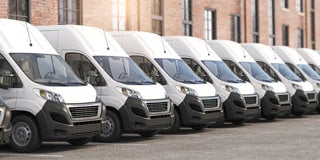
Managing vehicles from a risk point of view should be easier than managing drivers because there are more fixed rules. Cars and vans have to be taxed and MOT tested (at three years), new vehicles have to be serviced in line with manufacturers’ guidelines to maintain warranties, and heavy commercial vehicles come under O-licence regulations.
It was no surprise then when we at Driving for Better Business looked at the results from our online risk assessment and found that management of vehicles was the section where fleet operators got closest to where they should be, with an average user score of 65 against a target score of at least 73.
Many operators were, however, going much further towards best practice by utilising an array of advanced technologies that both protect the valuable assets themselves as well as helping to protect drivers. In fact, the two questions receiving the highest positive responses in the whole survey both come under vehicle management.
When asked “do you ensure your vehicles are always serviced within the manufacturer’s recommended guidelines and MOT’d on time?” 87% said yes, and a further 10% were working towards it, meaning only a handful weren’t taking this issue seriously enough. What is heartening is that all those responding must be confident in their record keeping and alerts for vehicles to ensure they don’t miss key dates for MOTs or services that are due.
The next best performing question was “are policies and procedures in place to promote regular vehicle checks to ensure they are in a safe, legal and well-maintained condition?” which scored a 78% positive response with 13% working towards. Perhaps more importantly, 62% also answer “yes” to a follow-up question of “do you have procedures in place to check these standards are being maintained?” with a further 16% working towards.
Putting policies in place
This is so important because putting policies in place is one thing, but ensuring they are followed, and any findings acted upon, is key.
Amey, one of our Business Champions, is among many companies with commercial vehicles that is exploiting digital technology and apps to facilitate driver daily walkaround checks. Simple to use and replacing a manual paper-based method, it allows the driver carrying out the inspection to speed up the process and submit the results in real-time from the app, and includes details such as photos, time and date stamps as well as notes on corrective action. Once the check is finished, the report is viewable via an online portal. Any failed vehicle compliance checks automatically generate reports which are sent to line managers for inspection and to guide employees on how to rectify any identified issues.
The most common technology used in vehicle management is telematics. Originally used for tracking vehicles, systems are now so sophisticated they provide a wealth of data on location, fuel efficiency, emissions, idling time, roadworthiness and, of course, driver behaviour.
When asked “have you installed telematics, tracking and/or vehicle cameras to your vehicles?” 57% replied yes with a further 14% working towards. We suspect a lot of fleets making up the 29% who said “no” were car-only fleets where telematics is much more difficult to implement – it encounters greater resistance from drivers, and the benefits are sometimes harder to quantify.
All Driving for Better Business Champions that operate commercial vehicles use telematics in some form and it has been central to their ability to manage both their vehicles and drivers. Collisions aside, data consistently shows poor driver behaviour has a significant adverse effect on wear and tear, fuel economy and emissions so it shouldn’t be surprising that most well-run fleets use it.
So why is this such an important part of vehicle management for our Business Champions?
Balfour Beatty uses it to unlock opportunities to gather data such as idling, mpg, CO2 and link it with ancillary equipment such as on-board weighing and gritter boxes, enabling rich data to be available that not only yields benefits in terms of driver safety but also assists in managing sustainability targets, financial benefits and contractual reporting obligations.
Almost instant improvement
Carnell Support Services installed telematics to help it understand driver behaviours. Intervention soon followed, targeting the drivers that needed it the most and driver performance improved almost instantly. In the first year, driving styles improved by 50% overall, reducing damage, wear and tear, fuel use and emissions.
Hertfordshire Independent Living Services fitted a telematics/driver coaching aid to its fleet of around 70 cars and, in less than 12 months, saw an 80% reduction in speeding events and more than 40% reduction in collisions, all of which reduced their fleet insurance and improved the end of life value of their vehicles.
Iron Mountain saw great success in reducing speeding events across its fleet. The fleet operates one of the strictest anti-speeding policies we’ve seen with its telematics system reporting an event every time the driver travels in excess of just 4mph over the posted limit (i.e. 35 in a 30 limit, 45 in a 40, etc.). Working with its drivers it was able to reduce speeding events by more than 80% so that now the company reports less than one event per week, per vehicle, despite collectively travelling in excess of 200,000 miles per week.
You might expect this to have dented Iron Mountain’s productivity but far from it! Its on-time delivery service KPI of 99.97% has not been affected. Consequently, the drivers now realise they don’t have to speed to get the job done.
Use of telematics is therefore a clear area where benchmarking your fleet performance can help. Many of our Business Champion case studies show graphs of collision reductions and further reductions in operational costs and emissions. It also makes it much easier to benchmark your fleet internally, where vehicles are split across multiple depots, teams or geographies, enabling you to see which areas are performing well and which need to improve.
Having looked at some excellent practices where companies are utilising technology to improve vehicle management and vehicle safety, the weakest area in this section is actually vehicle selection and procurement. Many businesses look closely at fuel efficiency and emissions with commercial operators opting for Euro 6 trucks and car fleet operators selecting cars with lower CO2 emissions.
Unnecessary vehicle damage
However, most operators are missing a trick here to protect both drivers and vehicles by reducing unnecessary vehicle damage with significant associated savings in third-party claims.
According to a study by EuroNCAP and ANCAP, fitment of autonomous emergency braking (AEB) systems leads to a 38% reduction in real-world rear-end crashes and, according to Thatcham Research, this leads to a 45% reduction in third party injury claims.
AEB is now a requirement for a car to achieve a EuroNCAP five-star rating yet only 33% of respondents answered “yes” to “do you insist on only purchasing/leasing/hiring vehicles that have attained a five-star EuroNCAP rating and which include the latest safety features such as autonomous emergency braking?”.
A follow-on question of “do you allow drivers of company cars to specify optional vehicle safety or advanced driver assistance systems even if they come at extra cost?” was only answered “yes” by 39% of firms.
Half of the respondents to both these questions said they weren’t even looking at this issue. The reasons most often given for not answering “yes” are that these systems are not fitted as standard to the cars they want, and that the additional cost of fitment as an option is too high. This is despite the wider fitment of AEB within company fleets being a stated objective within the Government’s British Road Safety Statement.
One such company that has taken on this approach is leasing company Arval, a Driving for Better Business Champion, which ensures all company cars are fitted with ABS, ESC (electronic stability control) and reversing sensors as mandatory features. The company car choice list also only includes vehicles that have scored five stars in EuroNCAP testing.
For car and van fleets, on-board vehicle safety systems and advanced driver assistance systems (ADAS) have well-proven safety benefits for drivers and financial benefits for the business. It is an area where operators now need to be showing significantly more interest.



















Login to comment
Comments
No comments have been made yet.